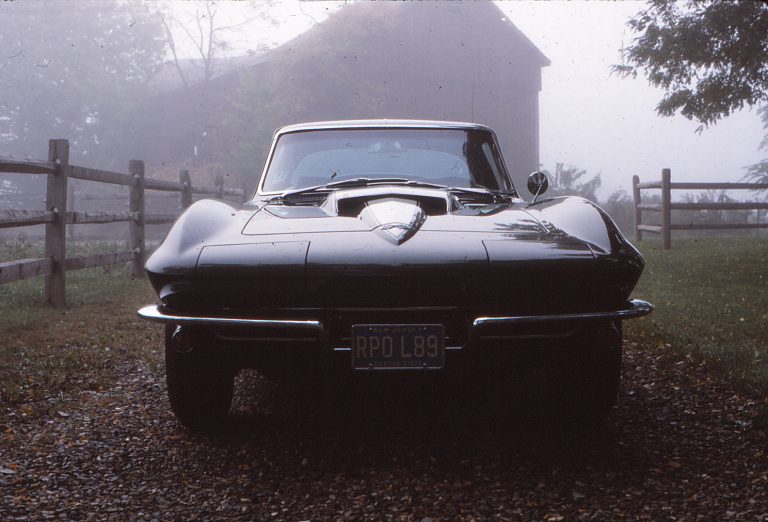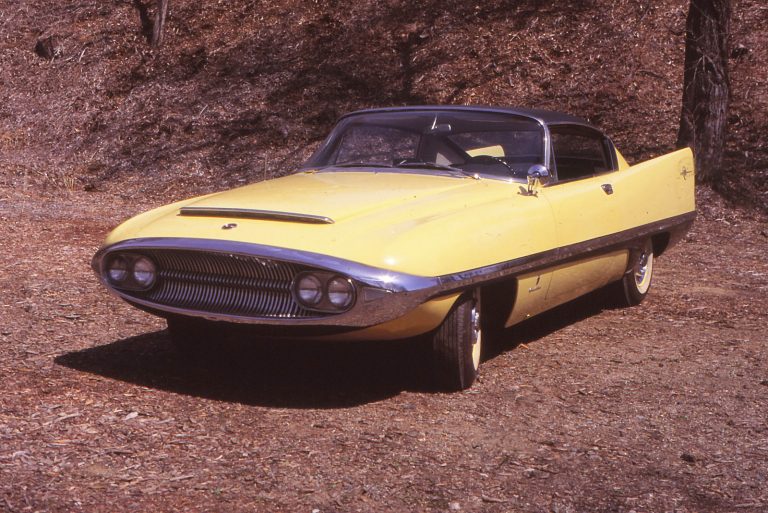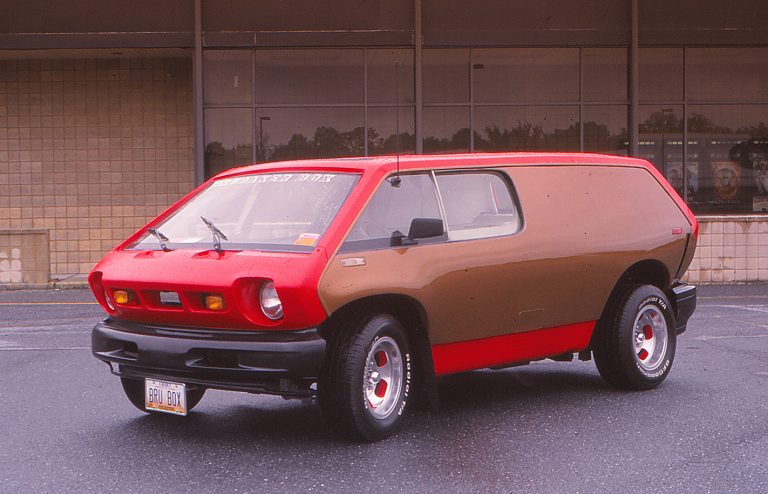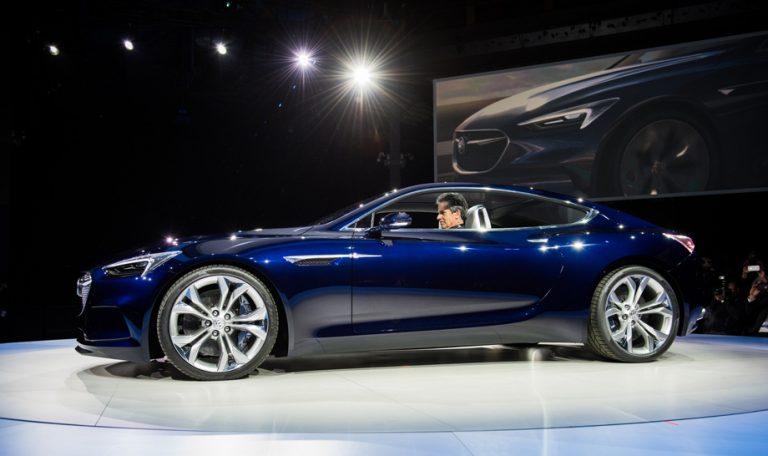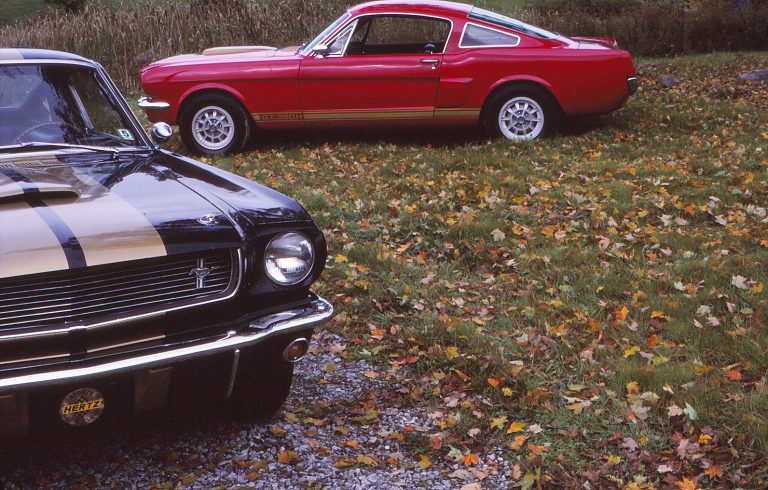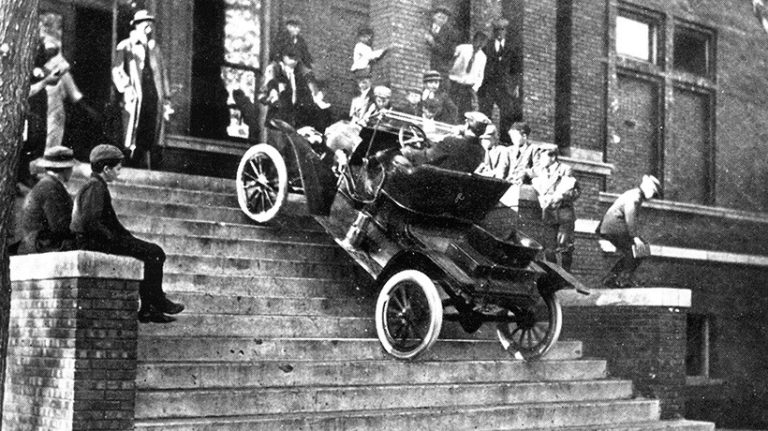Originally published in Automobile, February, 1991; republished by the author
“As impassable as the alleys of Stamboul; as filthy and mucky as the roads of the province of Nagpur.” Everywhere there were “pools of yellow slime.” The streets were paved, but the mud and slush lay in furloughs and windows. It was Chicago, and the Times-Herald reported that the understaffed city forces would be unable to clear the streets before Thanksgiving Day. That Thanksgiving, November 28, 1895, was a date set for the first automobile race in America, to be held on those very Chicago streets. The race would have to be held in the aftermath of one of the worst blizzards in years.
Herman Kohlsat had little choice. The race had already been postponed once. As publisher of the Chicago Times-Herald and sponsor of the contest, he knew that another delay with subject his plans – and the horseless carriage – to ridicule. The Chicago Tribune had mocked the “exhibition run” held on November 2, the date originally scheduled for the race but canceled when only two of the 80-five entrance were ready.
But Hieronymus Mueller, a Decatur, Illinois, manufacturer, had threatened to run the course alone and claim the advertised $2000 first prize. The exhibition run was Kholsat’s compromise, a ninety-two-mile round trip between Chicago and Waukegan, Illinois. Five hundred dollars would be shared by those completing the trip. What amused the Trib was that there were only two starters and only Mueller’s Benz victoria finished. The other, a Duryea prototype, crashed in a ditch to avoid hitting a farm wagon; a third entrant dropped out before the race began.
Monday’s blizzard forced another decision, one that Kohlsat delayed until the day before the race. But when the Mueller Bernz made a run of 10 miles through the re-drifting snow, the race was declared to be on. Still, on the eve of the race, only eleven entrants were planning to compete. There were the Mueller Benz and another Benz entered by the R.H. Macy company, the New York City Department store, which was considering selling the machines. Both were standard production victorious from the Mannheim, Germany, works. Power for each was a spark-ignited four-stroke single developing about three bhp at 700 RPM. The transmission was a pair of leather belts providing two forward speeds (but no reverse) and a maximum of about 17 mph under good conditions. Final-drive with chain and sprocket.
Another entry, the De La Vergne motor drag, had two single-cylinder Benz engines, balanced to minimize vibration. At 1800 pounds, it was the heaviest of all the gasoline entries. Having finished fifth in the Paris-Bordeaux race earlier in the year, it would provide an excellent benchmark for the competitors in the Chicago race. Or so it was hoped.
Frank Duryea would be racing the buggy that he and brother Charles had crashed in the exhibition run. The Duryea brother’s second vehicle – their first was America’s first successful gasoline-powered automobile –had a battery-sparked horizontally opposed twin and a geared transmission with three speeds forward and one reverse. Producing six bhp, its top speed in high was nearly 20 mph. It had seating for two and tiller steering and it weighed 700 pounds.
Another US-built entrant was the Haynes-Epperson Stintz, built in Kokomo, Indiana. The buggy, with its two-stroke engine, was a combined effort by Elwood Haynes and Edgar and Elmer Epperson. One of the smaller vehicles in the field, it was well proven, having first run almost a year and a half earlier. The Chicago-built Sturges Electric Motocycle was as large as the De La Vergne and, with its batteries, probably heavier. Another electric was the even then unconventional Morris and Solemn Electrobat (the name’s ending adapted from bainein, Greek for “to go”). The Philadelphia-based machine had twin motors turning the front wheels and was steered by the smaller rear wheels. The electrics, it was announced, were running for exhibition only; there were no supply stations for exchanging batteries so that they could go the full distance.
Two local entries were bicycle based: Max Hertel mounted a small two-cylinder engine between two cycle frames; and A. C. Ames perched a sleigh body atop two cycle frames and, with two fourteen-inch-stroke cylinders attached to each outboard pedal crank, entered the only steamer.
Chicagoan George Lewis gave no details about his large machine, and A. Baushke and Brother’s vehicle had not arrived from Benton Harbor, Michigan, but was still considered a starter.
Eleven racing drivers were certainly fewer than eighty-five, but it promised to be an interesting contest nonetheless: electrics against the gasoline engines, Americans against the foreigners, and everyone against the snow.
Race day was better, if only slightly, than the preceding days. The wind moderated, and the sun raised temperatures to a slush-making 39 degrees by midafternoon. “It was a nice day from the knees up,” one wag noted.
The course, in consideration of the weather, was shortened. Waukegan was impossible. Instead, Evanston would be the turnaround point; the start and finish, the Midway Plaisance and Jackson Park, scene of the 1893 Colombian Position. The northward leg would be direct, using Michigan Avenue and skirting Lake Michigan. The return would wind through parks and Chicago’s neighborhoods. The total distance was fifty-four very snowy, slushy miles.
At 8:30 a.m. Thursday, Thanksgiving Day, the Morris and Solom electric arrived at the start. It in the Macy Benz, the Duryea, the Sturges, and the de la Vern, which soon followed, had to push not only through the snow but also through a crowd estimated in the thousands. The Times-Herald reported that, like race fans ever since, the “Kodak teens took snapshots of everything in sight.”
Not to be seen yet was the Mueller Benz. New drive belts had been fitted, and they were slipping. Sand was being applied, but the Benz would not make the start on time. Others had it worse. The Haynes-Apperson, making a sharp turn to avoid a streetcar, smashed one of its bicycle-type front wheels. “Something snapped” in the Hertel’s steering gear. Ame’s steamer and Lewis’s local entry were both scratched, and Baushke vehicle had yet to reach Chicago.
Thus it appeared that only five would start. The race would be against the clock, the vehicles leaving at intervals of several minutes. Each would carry an umpire to take notes and ensure observance of the rules.
At 8:55 AM on November 28, 1895, a page in American history was written. Race judge C.F. Campbell shouted “go,” and the Duryea rolled into the crowd and deep snow. The first on Mobile race in America had begun.
If anyone at the time had reflected on the import of the moment, the spell would quickly have been broken. The De La Vergne, with Fredrick Haas at the small horizontal steering wheel, left only a minute later, followed by Jerry O’Connor driving the Macy Benz, Harold Sturges on his electric vehicle, and Henry Morris on his Electrobat.
Fully an hour later, the Mueller Benz did take the start. The Mueller was the only vehicle to carry three riders: operator Oscar Mueller (son of Hieronymus); Charles B. King, umpire; and Charles Reid, along as an assistant.
The De La Vern was in trouble immediately. Its weight and unaltered tires (all the other entrants had wrapped cord around theirs) resulted in the wheels spinning in virtually unbroken snow. Losing ground to the Duryea and passed by the Macy Benz, Haas surrendered, gaining the dubious distinction of becoming U.S. auto racing’s first DNF.
Michigan Avenue was packed with spectators. The Times-Herald’s “moderate estimate” was that 10,000 saw the Duryea leading the Macy Benz by minutes in the fifty-block stretch south of downtown. Passing through downtown, O’Connor crashed the Macy Benz into the rear of a horse-drawn streetcar, skidding on the snow-slicked tracks. Despite damaging the steering gear, he continued.
The Duryea soon broke its own steering gear on a high, snow-covered rail crossing and appeared to be finished when the Macy passed moments later. Frank Duryea, not to be stopped, found a blacksmith’s shop and persuaded the owner to open on the holiday morning. Almost an hour was lost, though, while he made repairs.
Despite the delay, the electrics had not overtaken the Duryea. They crawled along to conserve their charge, but both expired before noon, each having been overtaken by the late-starting Mueller Benz before withdrawing.
Meanwhile, Frank Duryea pursued the Macy Benz. The Duryea, it was reported, traveled noticeably faster than the collision-crippled Benz, chugging along at eight instead of six mph. A crowd waited at the first relay. At 11 o’clock, the Macy Benz came into view alone. O’Connor stopped to make adjustments and take on oil and water and in 10 minutes was underway. Twenty minutes later, the Duryea chugged through but without stopping.
The Macy carriage stopped again just beyond the station for more adjustments to the steering gear, and by the time they reached Evanson, the Duryea was pressing the Benz. Just before the turn south, O’Connor moved over in keeping with the rules so Duryea could pass.
The pair made the turn at 12:50 p.m. O’Connor kept close but was about to meet with the second collision of the race. A horse-drawn cutter caring De La Vernge pilot Haas and a reporter caught a runner in a “frog” in the streetcar tracks and overturned. O’Connor’s Macy Benz crashed into it. Finding no damage, he hurried on.
But he was barely underway again when a horse-drawn hack crossed his path. The Benz skidded in the slush and into the hack. Four wooden spokes in the Benz wheel were cracked, and worse, the steering gear was badly bent. The Benz could not be steered. The resourceful O’Connor took to the streetcar tracks and by staying in the ruts was able to reach the second relay station, having lost remarkably little time to Duryea. The department-store carriage would require an hour and a half of repairs. Duryea, however, was to pass the relay station without slowing.
All the while the Mueller Benz soldiered on alone, overtaking the electrics but not gaining on the leaders. The Macy and the Mueller had almost equal running times to the first relay station. After that point, though, the new leather belts on the Mueller began slipping badly again, and the Benz fell back. Stops were required to repair clutches bent by the bad roads and fix several sprocket and chain derailments. After a five-minute stop for fuel at the second relay, Oscar Mueller took off in pursuit of Duryea and O’Connor.
The Duryea seemed impossible to catch. Its engine was running well, and Frank Duryea took to the streetcar tracks, amazing onlookers with the speed of almost 20 mph. Maybe it was because of the speed, but a marker for a turn was missed, and Duryea continued on a route that would add two miles to his travels. It proved to be a propitious error, however. While on the detour, his car’s “igniter” broke, disabling one cylinder. But luckily he happened upon a tinsmith shot. The owner was rousted from his home to fashion a replacement, and the Duryea was underway again in fifty-five minutes. Learning of his navigational error, Duryea took a cross street to regain the course not far ahead of the two Benz machines.
Fewer and fewer spectators waited around as darkness approached. Shortly after 4:00 p.m, with shadows growing and the temperature falling, assistant Charles Reei passed out from exposure and was taken from the Mueller Benz.
A few minutes before six, the Macy followed the Duryea by twenty-five minutes. The Mueller Benz was not much further behind and was actually ahead on time. It was the closest the trio had been for the entire race. But at 6:15 p.m., the engine of the New York carriage failed. Jerry O’Connor worked at repairs in the refreezing slush until 11:30 p.m., but the fix could not be made until Friday morning, and the only then would the Macy Benz finish.
Although the Mueller Benz had come close to the Duryea, it would not catch it. The American machine clearly had the legs on its European rival. But without spectators, the occupants were compelled to make their own celebration, with “war whoops, cheers, catcalls, and other manifestations of joy over the victory they were winning,” according to the Times-Herald. At 7:15 p.m., after ten hours and twenty-three minutes of ice, slush, and winter wind, Frank Duryea drove his car over the finish line. An American automobile had won the first automobile race in America.
It was a small but hearty welcome for the victor, limited to reporters and a few others. The final miles had been seen by an estimated fifty people. So, under the street lamps, the first champions cheered themselves. When the cheering was done, they climbed upon their winnings steed and drove it thirty-five blocks north to its garage.
The race may have been won, but it was not over, at least not for Oscar Mueller and Charles King. Struggling on through snow and darkness, Mueller turned the Benz eastward on the final leg of the race. It had been a long, cold day, and he had eaten little. Probably most telling, though, was the alcohol the nondrinking Mueller had consumed to warm himself. He collapsed from the combined effect, and King took over the controls with one hand while he supported he supported Mueller with the other.
It was King at the wheel for the last hour, arriving at the finish at 8:53 p.m. to a lonelier, less jubilant welcome that had greeted Duryea. Oscar Mueller, only semiconscious, was lifted from the carriage and driven away in a hack. King left for dinner by himself – where, covered in ice and mud, he was turned away as a bum until he explained that he had participated in the big race; he was thereupon accorded a hero’s welcome.
It was, as they say, all over but the shouting, but there was plenty of that. No one, it seems, had completed the race without breaking some of the rules. Indeed, no one had a clear claim on first place. A decision was not announced for a full week: The real purpose, the judges then rationalized, was not to hold a speed contest but to promote the invention and development of motor vehicles. This aim had been successful.
The best car, based primarily on its performance in the race, was the Duryea, so it was awarded the $2000 first prize. Similarly, the Mueller Benz received the $1500 second prize, and third prizes of $500 went to both the Macy Benz and the Sturges. The Morris and Salom was awarded a gold medal for efficiency of operation. The Lewis, Hertel, Haynes-Apperson, and De La Vergne entries were also awarded cash prizes for various technical innovations.
The Times Herald noted that the race “demonstrated conclusively the practicality of the horseless carriage,” and this analysis might be the most accurate of all. The race did promote the development of the automobile in the United States. It brought together American automotive “experimentalists” for the first time. Organizing efforts for the race resulted in the formation of the American Motor League, the first – if not the longest lived – automobile association in the world. And within a year, with capital and customers generated in part by the race, the Duryea Motor Wagon Company would produce thirteen identical automobiles, the first example of U.S. mass auto production.
In effect, the race promoted the automobile from a curiosity to an accepted idea in the mind of the American public. Resistance would continue, but a new era had begun. Along those snowy Chicago streets, America accepted the automobile.
Addendum: The primary source for this article was a copy of the Chicago Times-Herald in the Library of Congress. It was crumbling as I used it and took photographs so I could read it later. After I finished using it, I recommended to the librarian that it should be taken out of circulation until it could be copied.
There have been various articles written about the 1895 race, and one common error, likely passed from one incorrect secondary source to the next, has the race taking place in the aftermath of snow storm on the day before Thanksgiving, with the cars having to driving through blowing and drifting snow. Photos, however, show a sunny day, warm and sloppy, the melting snow befouled by horse pollution.
Frank Duryea, in his autobiography, mentions heavy snow having fallen the day before. Apparently his memory was flawed, however. He was there, but the newspaper was written at the time.
Mercedes-Benz incorrectly reports the victor of the race as the Mueller Benz. The claim references the exhibition run, not the official race.
The article I wrote mentioned the race course skirting the University of Chicago’s football field and fans in the stands turning to the street and cheering as the automobiles drove by. The paragraph wound up on the cutting floor. Did someone at Automobile take issue with the University of Michigan beating the Chicago Maroons? We’ll likely never know.












